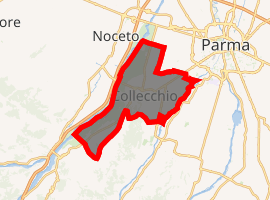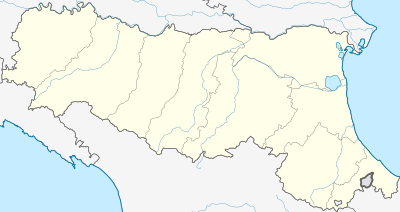Collecchio
Collecchio (Parmigiano: Colècc') is a town in the province of Parma, Emilia-Romagna, northern Italy. It is located 12.9 kilometres (8.0 mi) by road southwest of the centre of Parma.[3] A major food-producing area, it is home to multinational Italian dairy and food corporation Parmalat and Parma F.C.'s training complex, Centro Sportivo di Collecchio, and is connected by railway.[4]
Collecchio | |
|---|---|
| Comune di Collecchio | |
 Collecchio Piazza Libertà | |
Location of Collecchio 
| |
 Collecchio Location of Collecchio in Italy  Collecchio Collecchio (Emilia-Romagna) | |
| Coordinates: 44°45′N 10°13′E | |
| Country | Italy |
| Region | Emilia-Romagna |
| Province | Parma (PR) |
| Frazioni | Case Quintavalla, Case Zingari, Collecchiello, Folli, Gaiano, Giarola, La Corte Anguissola, La Ripa, Lemignano, Madregolo, Maiatico, Oppiano, Ozzano Taro, Ponte Scodogna, San Martino Sinzano, Stradella, Villa Lucia, Villanuova, Villa Vecchia |
| Government | |
| • Mayor | Paolo Bianchi |
| Area | |
| • Total | 58 km2 (22 sq mi) |
| Elevation | 112 m (367 ft) |
| Population (31 December 2014)[2] | |
| • Total | 1 |
| • Density | 0.017/km2 (0.045/sq mi) |
| Demonym(s) | Collecchiesi |
| Time zone | UTC+1 (CET) |
| • Summer (DST) | UTC+2 (CEST) |
| Postal code | 43044 |
| Dialing code | 0521 |
| ISTAT code | 034009 |
| Patron saint | St. Prosper |
| Saint day | 24 November |
| Website | Official website |
History
The first signs of settlement in Collecchio date from the Paleolithic Age. Under the Romans it was called Sustrina and later, in Christian times, Colliculum, because of its location on a small hill. With growing numbers of inhabitants in the Neolithic, deforestation led to flooding in the plains. As a result, settlements were moved up into the hills. Collecchio's history is tied closely to that of nearby Parma under whose powerful bishops the city was ruled.[5] The Roman road Clodia Segunda linking Parma and Luni (via Fornovo) and the Cisa Pass was a mainstay for the local economy and for the development of the ancient Roman city of Sustrina. The road can still be seen today, branching off to the left just before the bridge over the River Taro after leaving Parma on the Via Aemilia.
The town is first mentioned in a document from 929 which refers to "ad castro Coliclo", although it is uncertain whether Collecchio ever actually had a real castle although it did have a fortified Lombard court. In 1000, the Lombard Countess Ferlinda gave a hospice to the canons of Parma in Madregolo. In 1173, there is a reference to the court of Collecchio as property owned by the monastery of San Paolo. After the year 1000, Collecchio was the centre of battles between the Visconti, Rossi, Pallavicino and Sforza families until in 1545 Parma became a duchy in the hands of the Farnese family. In 1777, further feuding brought Collecchio under the rule of the Dalla Rosa-Prati family. In 1796, under Napoleon, the Commune of Collecchio was born.[5]
At the end of the 19th century, Collecchio began to develop as an agricultural centre for canning and meat products in what has become known as Italy's food valley. In particular, the area became the driving force behind the Italian charcuterie industry with pioneers such as Archimede Rossi and Domenico Ferrari. Collecchio also began to produce dairy products including Parmesan cheese.[5]
On 27 April 1945, the town was liberated from German Nazi forces by the Brazilian Expeditionary Force in the Battle of Collecchio. Approximately 400 Germans were captured after two days of battle.[6]
In 2015, the town introduced legislation mandating the use of 'silent' fireworks in consideration of animals.[7]
Main sights
A major food-producing area, it is home to the multinational Italian dairy and food corporation Parmalat and Parma F.C.'s training complex, Centro Sportivo di Collecchio, and Il Collecchio Baseball Club, a baseball team established in 1974.[8]
Architecturally of note is the Pieve di San Prospero and Villa Paveri-Fontana, formerly Villa Dalla Rosa-Prati. Villa Paveri-Fontana was built in the late 17th century on a pre-existing 16th-century building. It still keeps rooms painted with mythological and architectural perspective. At the entrance stands on the right (if coming from Parma) is a monumental arched entrance, called the "L'Arco del Bargello" which marks the entrance to the park. Villa Meli-Lupi di Soragna, located in the Fortunato Nevicati park is an example of special architectural structures as it depicts a nut, with the front moved by small columns forming a portico, and a corner tower.
People
- Riccardo Fainardi (1865–1959), painter and interior designer
- Gherardo Segarelli, (c. 1240 – 1300), founder of the Apostolic Brethren
- Calisto Tanzi (1938–), businessman
Twin towns — sister cities
References
- "Superficie di Comuni Province e Regioni italiane al 9 ottobre 2011". Istat. Retrieved 16 March 2019.
- All demographics and other statistics from the Italian statistical institute (Istat)
- Maps (Map). Google Maps.
- "Comune di Collecchio", Emilia Romana in festa. (in Italian) Retrieved 12 July 2012.
- "Comune di Collecchio", Gli Itinerari della Francigena. (in Italian) Retrieved 12 July 2012.
- Dulles, John W. F. (1978). Castello Branco: the making of a Brazilian president. Texas A&M University Press. pp. 153–4. ISBN 978-0-89096-043-1. Retrieved 12 July 2012.
- |url=http://travel.excite.co.uk/town-in-italy-starts-using-silent-fireworks-as-a-way-of-respecting-their-animals-N52632.html | accessdate=6 Jan 2016
- "Sport". Alberghi Collecchio. Archived from the original on 16 December 2012. Retrieved 16 July 2012.
